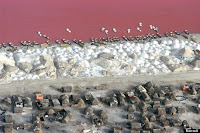Naica Mine
Intrduce :
Discovered by two miners looking for lead, these amazing crystal-lined caves could be mistaken for Superman's ethereal Arctic lair.
These stunning white beams of gypsum have been growing at a snail's pace for hundreds of thousands of years in caves below Naica in Mexico.
Ten years after the amazing discovery, scientists are petitioning the Mexican government to claim for Unesco World Heritage status to protect the unique formations for future generations.
These stunning images, which were taken by world-renowned Spanish photographer Javier Trueba, show the sheer size of the crystals, some of which measure up to 11 metres.
Growing slowly over time, it is still unclear why the formations fill the caves at such haphazard angles.
The huge mines at Naica have been excavated for years, but in 1975 a massive area was drained so mining operations could take place.
When the water disappeared the crystals stopped growing, however, it was more than 25 years before two miners stumbled across the vast Crystal Caves and the incredible collection of gypsum was discovered.
The formation of the beams 290 metres below the surface, occurred when super-heated water began cooling and became saturated with gypsum.
Over time, crystals formed in the water.
One of the major problems still facing scientists wishing to study below the ground at Naica is the heat.
A hot spring located close to the Crystal Caves means the temperature is too hot for people to remain in the crystal chamber for longer than ten minutes at a time.
Fortunately, other sections of the mine are air-conditioned.
Location :



















































